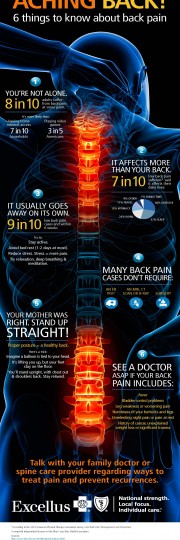
Rochester, NY, March 9, 2016 (Newswire.com) - More upstate New Yorkers with back pain are undergoing surgery and taking prescription medication (including opiate painkillers), even though noninvasive treatments such as simple exercises and over-the-counter drugs usually work, according to a new Excellus BlueCross BlueShield report.
“If patients receive the wrong back pain care at the wrong time, it could actually lead to worse outcomes,” said Dr. Brian Justice, a chiropractor and medical director at Excellus BlueCross BlueShield. “Back pain is not a disease in search of a cure. It’s a part of life that needs to be managed.”
"Back pain is not a disease in search of a cure. It's a part of life that needs to be managed."
Dr. Brian Justice, Chiropractor and medical director, Excellus BlueCross BlueShield
In their lifetimes, more than 80 percent of upstate New York adults will experience low back pain, nearly two-thirds will experience neck pain, and some will endure chronic suffering.
According to the report, Spine care in upstate New York:
- Surgeries for the treatment of back pain among upstate New York adults saw a 10 percent rise in utilization from 2010 to 2013.
- There was nearly a 14 percent increase in spine patients who were prescribed a medication within the first six weeks of diagnosis from 2010 to 2013.
- In 2013, almost half of patients treated for spine pain received a prescription for medication to treat the condition within the first six weeks of diagnosis. More than half of patients who were prescribed medications received a prescription for an opiate.
- In 2013, 626,000 upstate New York adults ages 18 and older received back and/or neck pain care that added nearly $1 billion to total, direct health care costs in the region. About 36 percent of that amount was spent on surgery, 32.2 percent was spent on diagnostic services and physician visits, and 32.9 percent was spent on non-surgical interventions.
Choosing Wisely, an initiative of the American Board of Internal Medicine Foundation, collected the following care recommendations on treatment of spine pain from physician-led medical specialty societies:
- The American Academy of Family Physicians advises spine pain patients to initially avoid imaging, due to the risks associated with radiation, the likelihood that additional and unnecessary tests and procedures without improved outcomes will follow, and also the high cost.
- The North American Spine Society does not recommend magnetic resonance imaging in the first six weeks of care for patients with nonspecific acute low back pain, nor does it recommend bed rest for more than 48 hours when treating low back pain.
- The American Academy of Physical Medicine and Rehabilitation recommends that health care providers only prescribe opiates for acute disabling low back pain after an evaluation and when other alternatives have been tried. Prescribing opiates early for acute disabling low back pain is associated with longer disability, higher surgical rates and a greater risk of later opioid use.
The goals of the Choosing Wisely initiative are to improve the quality of care and encourage physician-patient conversations about services that may be unnecessary and may cause harm.
"As a primary care physician, spine pain is one of the more common conditions that I treat,” said Joseph DiPoala Jr., M.D., president of the Monroe County Medical Society. “I see cases of chronic or acute neck or low back pain virtually every day. Fortunately, almost all of the acute cases of spine pain resolve on their own within a few weeks.”
“I think it is very important for patients to understand the role of imaging tests such as CAT scans or MRIs,” added DiPoala, of Ridgeview Internal Medicine in Irondequoit. “In the absence of signs of infection, cancer, weakness or change in bowel or bladder function, an MRI or CAT scan will likely not help the patient even with significant pain. It's also important for patients to understand that it's very common for an MRI or CAT scan to show abnormalities that have nothing to do with the patient's pain and/or for which there are not definitive treatments like surgery."
Recommendations for patients with low back pain
If you have low back pain, the research we compiled in our report advises staying active, limiting bed rest, using pillows between or beneath the knees when you sleep, applying heat for pain management, taking over-the-counter medications when needed, consulting your primary care provider or alternative non-surgical treatment provider (such as a physical therapist and chiropractor) if needed and remaining relaxed to avoid worsening pain.
To view “The facts about spine care in upstate New York, 2013” ‒ excellusbcbs.com/factsheets. To view an accompanying infographic ‒ brand.excellusbcbs.com.infographics/backpain.php and video – youtube.com/excellusbcbs.
Media Contact: Joy Davia Auch, Excellus BlueCross BlueShield, (585) 238-4374
# # #
Excellus BlueCross BlueShield, a nonprofit independent licensee of the BlueCross BlueShield Association, is part of a family of companies that finances and delivers vital health care services to about 1.5 million people across upstate New York. Excellus BlueCross BlueShield provides access to high-quality, affordable health coverage, including valuable health-related resources that our members use every day, such as cost-saving prescription drug discounts and wellness tracking tools. To learn more, visit excellusbcbs.com.
Share:
